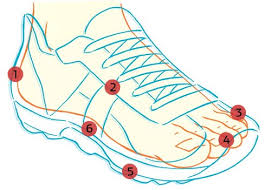Your guide to what type of running shoe you should wear

Ever been to a running shoe store and had a sales associate look at your feet and tell you that you require a ‘stability shoe’ or a ‘motion control shoe’…..or worse tell you that you are a dreaded ‘overpronator’?
What if we told you that none of that matters?
Those of you that know us probably know that we don’t mind ‘stirring the pot’ a little bit when we feel it’s appropriate.
For years when folks ask us what type of shoes we think they should run in to match their foot type we typically tell them it doesn’t matter. We have probably told many of you about these 3 studies on over 7000 army, navy, and Air Force recruits. During boot camps (where a ton of injuries occur) half of the participants were given shoes to match their arch height (neutral, stability, or motion control) while the other half of the recruits were all given stability shoes regardless of their foot type. You can probably guess, but there was zero difference in injury rates.
So what footwear changes do we prescribe when people present with chronic running related injuries?
Sometimes none.
Yup. None.
We find a completely different intervention to be considerably more effective. A slow motion run gait analysis and subsequent recommendations.
Recently this paper came out in the British Journal of Sports Medicine co-authored by one of the worlds leading running researchers, and a Canadian physiotherapist (who happens to run marathons in 2 hours, 35 minutes).
This editorial is our favorite kind of paper…….because it validated what we have been saying for years.
You see running shoe prescription seems to go through cycles. When we were kids our parents always looked for shoes with the most support, so we grew up running in rigid shoes with little give. Then books like Born to Run came out and there seemed to be a worldwide ‘hate’ for contemporary shoes and you would start seeing people running in vibram five fingers, or even completely barefoot. Recently, things seem to be swinging the other way with the dramatic rise in popularity of ‘maximalist’ shoes like hokas. All of these changes were predicated on supposedly reducing the risk of running related injuries.
And yet…..none have reliably been shown to have any impact at all on injury rates.
But still we consistently have injured runners coming in stating their shoes must be wrong for their feet.
To exhibit how harsh the authors of the above paper were on choosing shoes based on foot type, here is a quote directly from the paper: “runners should be instructed to choose a certain type of running shoe over another shoe no more so than a blue shoe over a red shoe.”
Ouch!
What does the research suggest ACTUALLY works? GAIT RETRAINING! The authors cite a recent study of 320 runners that had a 62% reduction in injury and lower loading rates (think hitting the ground lighter) after just 2 weeks of gait retraining. The best part? The changes lasted at a 1 year follow up.
We did have one (big) issue with this article. It essentially said that every method of choosing shoes is wrong…..yet it offered no alternative methods to try! This doesn’t provide any guidance for us to provide our injured runners.
When we see injured runners in clinic that ask us about footwear we typically will not offer any advice until we watch them run as we know that gait retraining interventions will go much further in reducing injury then changing their shoes to begin with.
Sometimes a footwear recommendation will go in tandem with a specific gait intervention we are recommending. For example If we are trying to increase cadence, we may transition to a slightly lower heel toe drop. If the person is having midfoot problems associated with hitting the ground too hard we may recommend a more cushioned shoe. Other times people just want to be faster and we recommend a lighter shoe.
If we aren’t matching a type of shoe to a specific recommendation then we always side with comfort. We suggest going to a running shoe store, ignoring much of what the sales staff will try and sell you, try on a number of shoes and run on their treadmill. Whichever feels best is probably right for you. A great Canadian researcher named Benno Nigg thinks that each person has an individual way of running that is best for them. Finding a shoe based solely on comfort is likely the best way to keep the person running that specific way.
Sometimes simplicity wins.
